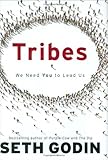 Leaders create change. That’s my one-sentence summary of Tribes by Seth Godin.
Leaders create change. That’s my one-sentence summary of Tribes by Seth Godin.
Godin defines a tribe as a group of people connected to one another, connected to a leader, and connected to an idea. Only two things are needed: a shared interest and a way to communicate.
The book is a call-to-action to make change. Thanks to the social web, Godin explains that individuals have more leverage than ever before. The barriers to leadership have fallen, and tribes can be everywhere now. (He reminds us that the power of tribes has nothing to do with technology, though, and everything to do with people.) People are just waiting to be engaged and transformed, as we all want connection and growth and something new.
Take a moment and consider all of the existing and potential tribes within and related to your institution – those who are yearning for leadership and connection…to be part of something that matters.
What’s holding us back then? Factory and fear. Godin says that we’re “stuck acting like managers or employees instead of like the leaders we could become. We’re embracing a factory instead of a tribe.” Secondly, fear – we’re worried about criticism. “Changing things – pushing the envelope and creating a future that doesn’t exist yet (at the same time you’re criticized by everyone else) requires bravery.”
My favorite part of the book was the concept of “heretics” – those who challenge the status quo and create movements. Heretics don’t settle; they’re willing to stand up and put their ideas on the line. Tribes was the second reading in our office book club (following The Power of Less) and inspired us to develop a presentation about changing the status quo to grow our university. My colleague John Dalton and I will present “The Heretic’s Guide to Marketing to Millennials” at the upcoming eduWeb Conference July 26-28 in Chicago.
Why challenge the status quo? Quite simply, it gives you a chance to be remarkable. The marketplace is now rewarding people who do things differently and create change. “Established in 1906,” for example, used to be important. Now it can be a liability.
Without chapters, the book bounces around a lot, but that’s part of its conversational appeal. The stories and the takeaways about leadership are indelible. Some of my favorite tidbits from Godin:
- It’s discomfort that creates the leverage that makes leadership worthwhile.
- Leaders use passion and ideas to lead people.
- The secret of leadership is simple: Do what you believe in. Paint a picture of the future. Go there. People will follow.
- Leaders connect their followers to one another. Leadership is the art of giving people a platform for spreading ideas that work.
- Leadership is not management. Managers make widgets (managing a process they’ve seen before); leaders make change.
- Leadership almost always involves thinking and acting like an underdog.
- Leaders have one thing in common: the decision to lead.
And then what I think is the best line in the entire book: “If your organization requires success before commitment, it will have neither.”
Go ahead; create a movement. Find something worth changing, assemble a tribe, and spread the idea. As Godin says, we need you.




